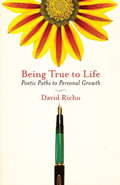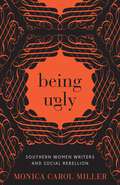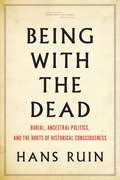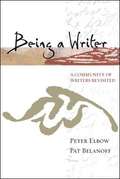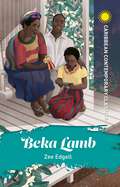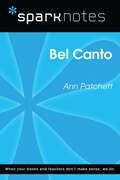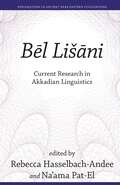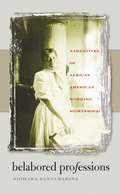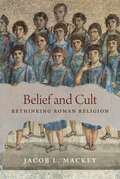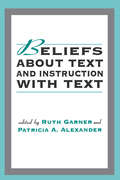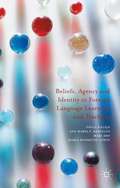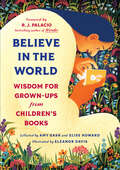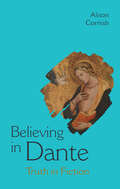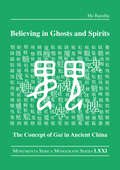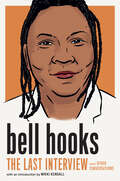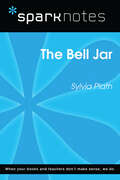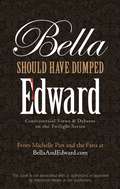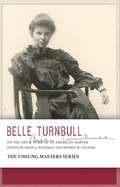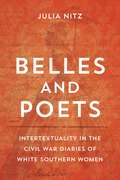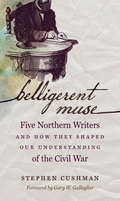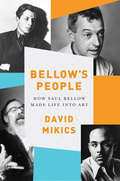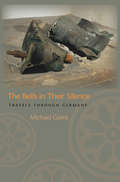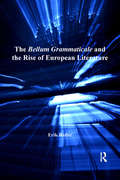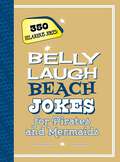- Table View
- List View
Being True to Life: Poetic Paths to Personal Growth
by David RichoPsychotherapist David Richo offers a fresh and inspiring approach to personal growth: we can use the process of writing and reading poetry to move toward greater self-understanding and emotional healing. Even if you've never written a poem before, you can learn to use poetry to explore your feelings, your relationships, your childhood, your dreams, and more.Richo explains how the creative, intuitive process of making poetry can help us gain access to our deepest truths, leading us to make connections and explore experiences in a new way, beyond the constraints of everyday language. This book offers a range of practical exercises for getting started, as well as guidance on how to read poetry in a way that can be personally transformative.Being True to Life shows us that poetry is not reserved for a few specially talented individuals but is a deeply human activity that anyone can tap into for greater clarity and insight into life's struggles, beauty, and mysteries.
Being Ugly: Southern Women Writers and Social Rebellion (Southern Literary Studies)
by Monica Carol MillerIn the South, one notion of “being ugly” implies inappropriate or coarse behavior that transgresses social norms of courtesy. While popular stereotypes of the region often highlight southern belles as the epitome of feminine power, women writers from the South frequently stray from this convention and invest their fiction with female protagonists described as ugly or chastised for behaving that way. Through this divergence, “ugly” can be a force for challenging the strictures of normative southern gender roles and marriage economies. In Being Ugly: Southern Women Writers and Social Rebellion, Monica Carol Miller reveals how authors from Margaret Mitchell to Monique Truong employ “ugly” characters to upend the expectations of patriarchy and open up more possibilities for southern female identity. Previous scholarship often conflates ugliness with such categories as the grotesque, plain, or abject, but Miller disassociates these negative descriptors from a group of characters created by southern women writers. Focusing on how such characters appear prone to rebellious and socially inappropriate behavior, Miller argues that ugliness subverts assumptions about gender by identifying those who are unsuitable for the expected roles of marriage and motherhood. As opposed to familiar courtship and marriage plots, Miller locates in fiction by southern women writers an alternative genealogy, the ugly plot. This narrative tradition highlights female characters whose rebellion offers a space for re-imagining alternative lives and households in opposition to the status quo. Reading works by canonical writers like Zora Neale Hurston, Flannery O’Connor, and Eudora Welty, along with recent texts by contemporary authors like Helen Ellis, Lee Smith, and Jesmyn Ward, Being Ugly offers an important new perspective on how southern women writers confront regressive ideologies that insist upon limited roles for women.
Being with the Dead: Burial, Ancestral Politics, and the Roots of Historical Consciousness (Cultural Memory in the Present)
by Hans RuinPhilosophy, Socrates declared, is the art of dying. This book underscores that it is also the art of learning to live and share the earth with those who have come before us. Burial, with its surrounding rituals, is the most ancient documented cultural-symbolic practice: all humans have developed techniques of caring for and communicating with the dead. The premise of Being with the Dead is that we can explore our lives with the dead as a cross-cultural existential a priori out of which the basic forms of historical consciousness emerge. Care for the dead is not just about the symbolic handling of mortal remains; it also points to a necropolitics, the social bond between the dead and living that holds societies together—a shared space or polis where the dead are maintained among the living. Moving from mortuary rituals to literary representations, from the problem of ancestrality to technologies of survival and intergenerational communication, Hans Ruin explores the epistemological, ethical, and ontological dimensions of what it means to be with the dead. His phenomenological approach to key sources in a range of fields gives us a new perspective on the human sciences as a whole.
Being A Writer: A Community of Writers Revisited
by Peter Elbow Patricia BelanoffBeing A Writer is a brief rhetoric that explores writing processes with an emphasis on their variety; invention, with an emphasis on its playfulness; revision as a technique of invention; collaboration as a means of revision; and personal engagement in academic writing, from literary analysis to argument.
Beka Lamb (Caribbean Contemporary Classics)
by Zee EdgellThere have been many great and enduring works of literature by Caribbean authors over the last century. The Caribbean Contemporary Classics collection celebrates these deep and vibrant stories, overflowing with life and acute observations about society.Set in Belize City in the early 1950s, Beka Lamb is the record of a few months in the life of Beka and her family. Beka and her friend Toycie Qualo are on the threshold of change from childhood to adulthood. Their personal struggles and tragedies play out against a backdrop of political upheaval and regeneration as the British colony of Belize gears up for universal suffrage, and progression towards independence. The politics of the colony, the influence of the mixing of races in society, and the dominating presence of the Catholic Church are woven into the fabric of the story to provide a compelling portrait, 'a loving evocation of Belizean life and landscape'. Beka's vibrant character guides us through a tumultuous period in her own life and that of her country.
Beka Lamb (Caribbean Contemporary Classics)
by Zee EdgellThere have been many great and enduring works of literature by Caribbean authors over the last century. The Caribbean Contemporary Classics collection celebrates these deep and vibrant stories, overflowing with life and acute observations about society.Set in Belize City in the early 1950s, Beka Lamb is the record of a few months in the life of Beka and her family. Beka and her friend Toycie Qualo are on the threshold of change from childhood to adulthood. Their personal struggles and tragedies play out against a backdrop of political upheaval and regeneration as the British colony of Belize gears up for universal suffrage, and progression towards independence. The politics of the colony, the influence of the mixing of races in society, and the dominating presence of the Catholic Church are woven into the fabric of the story to provide a compelling portrait, 'a loving evocation of Belizean life and landscape'. Beka's vibrant character guides us through a tumultuous period in her own life and that of her country.
Bel Canto (SparkNotes Literature Guide Series)
by SparkNotesBel Canto (SparkNotes Literature Guide) by Ann Patchett Making the reading experience fun! Created by Harvard students for students everywhere, SparkNotes is a new breed of study guide: smarter, better, faster.Geared to what today's students need to know, SparkNotes provides:chapter-by-chapter analysis explanations of key themes, motifs, and symbols a review quiz and essay topicsLively and accessible, these guides are perfect for late-night studying and writing papers.
Bēl Lišāni: Current Research in Akkadian Linguistics (Explorations in Ancient Near Eastern Civilizations)
by Rebecca Hasselbach-Andee and Na’ama Pat-ElAkkadian, a Semitic language attested in writing from 2600 BCE until the first century CE, was the language of Mesopotamia for nearly three millennia. This volume examines the language from a comparative and historical linguistic perspective. Inspired by the work of renowned linguist John Huehnergard and featuring contributions from top scholars in the field, Bēl Lišāni showcases the latest research on Akkadian linguistics. Chapters focus on a wide range of topics, including lexicon, morphology, word order, syntax, verbal semantics, and subgrouping. Building upon Huehnergard’s pioneering studies focused on the identification of Proto-Akkadian features, the contributors explore linguistic innovations in the language from historical and comparative perspectives. In doing so, they open the way for further etymological, dialectical, and lexical research into Akkadian. An important update on and synthesis of the research in Akkadian linguistics, this volume will be welcomed by Semitists, Akkadian language specialists, and scholars and students interested in historical linguistics. In addition to the editors, the contributors to this volume include Paul-Alain Beaulieu, Øyvind Bjøru, Maksim Kalinin, N. J. C. Kouwenberg, Sergey Loesov, Jacob J. de Ridder, Ambjörn Sjörs, Michael P. Streck, and Juan-Pablo Vita.
Belabored Professions
by Xiomara SantamarinaAccording to nineteenth-century racial uplift ideology, African American women served their race best as reformers and activists, or as "doers of the word." In Belabored Professions, Xiomara Santamarina examines the autobiographies of four women who diverged from that ideal and defended the legitimacy of their self-supporting wage labor.Santamarina focuses on The Narrative of Sojourner Truth, Eliza Potter's A Hairdresser's Experience in High Life, Harriet Wilson's Our Nig, and Elizabeth Keckley's Behind the Scenes. She argues that beyond black reformers' calls for abolitionist work, these former slaves and freeborn black women wrote about their own overlooked or disparaged work as socially and culturally valuable to the nation. They promoted the status of wage labor as a mark of self-reliance and civic virtue when many viewed African American working women as "drudges." As Santamarina demonstrates, these texts offer modern readers new perspectives on the emergence of the vital African American autobiographical tradition, dramatizing the degree to which black working women participated in and shaped American rhetorics of labor, race, and femininity.
Belief and Cult: Rethinking Roman Religion
by Jacob L. MackeyA groundbreaking reinterpretation that draws on cognitive theory to show that belief wasn’t absent from—but rather was at the heart of—Roman religionBelief and Cult argues that belief isn’t uniquely Christian but was central to ancient Roman religion. Drawing on cognitive theory, Jacob Mackey shows that despite having nothing to do with salvation or faith, belief underlay every aspect of Roman religious practices—emotions, individual and collective cult action, ritual norms, social reality, and social power. In doing so, he also offers a thorough argument for the importance of belief to other non-Christian religions.At the individual level, the book argues, belief played an indispensable role in the genesis of cult action and religious emotion. However, belief also had a collective dimension. The cognitive theory of Shared Intentionality shows how beliefs may be shared among individuals, accounting for the existence of written, unwritten, or even unspoken ritual norms. Shared beliefs permitted the choreography of collective cult action and gave cult acts their social meanings. The book also elucidates the role of shared belief in creating and maintaining Roman social reality. Shared belief allowed the Romans to endow agents, actions, and artifacts with socio-religious status and power. In a deep sense, no man could count as an augur and no act of animal slaughter as a successful offering to the gods, unless Romans collectively shared appropriate beliefs about these things.Closely examining augury, prayer, the religious enculturation of children, and the Romans’ own theories of cognition and cult, Belief and Cult promises to revolutionize the understanding of Roman religion by demonstrating that none of its features makes sense without Roman belief.
Beliefs About Text and Instruction With Text
by Ruth Garner Patricia A. AlexanderEvery day in classrooms, teachers and students think about and with text. Their beliefs about what text is, who created it, and how to evaluate it are an influence, often a profoundly important one, on how they use text. This book brings together research on epistemology, belief systems, teacher beliefs, and text -- research that is usually presented separately, and in different disciplines. The editors illustrate what a cross-disciplinary body of work looks like, what varied insights are possible, and when the central concerns are beliefs and text. Written by respected researchers in the fields of psychology and education, the chapters are clustered thematically into three sections: * childrens' and adults' beliefs about text. * beliefs about what should be taught and how particular content should be taught and assessed in classrooms. * commentary on knowing versus believing, on the literatures that inform this body of work, and on belief systems. The first to address this important topic in a single volume, this book provides an essential synthesis of current research in an active area of inquiry. The chapters are pieces framed in a time and place with particular intentions -- one of those intentions is that they separately and as a whole stimulate discussion about beliefs and text.
Beliefs, Agency and Identity in Foreign Language Learning and Teaching
by Paula Kalaja Ana Maria F. Barcelos Mari Aro Maria Ruohotie-LyhtyThis book explores the phenomena of believing (or giving personal meanings), acting, and identifying (or identity construction), and the interconnectedness of these phenomena in the learning and teaching of English and other foreign languages.
Believe In the World: Wisdom for Grown-Ups from Children's Books
by Amy Gash Elise HowardAn inspiring and delightful illustrated collection of quotations from a diverse range of our most beloved children's books that will help teach all of us how to live in the world today, perfect for gift season and for readers of books like The Boy, The Mole, The Fox, and The Horse and How to Love the World. Everything we need to know as adults can be found in the brilliant, imaginative, diverse world of children's books. That is the simple yet powerful promise that Believe In the World offers. This illustrated, gifty collection, with witty and inspirational quotations organized in chapters such as "How to Believe in the World" and "How to Have Fun in the World," reminds us not to lose sight of the values we learned as kids—to be courageous, to do good deeds, to respect our imaginations, and maybe even to break a few rules every once in a while. Some quotations will bring readers back to old favorites like The Little Prince or Ramona Forever while others will lead to new discoveries inspired by the exciting new variety of children&’s books being published today. And all provide a roadmap to doing and being good in the world. As one reviewer wrote about Believe In the World's predecessor, What the Dormouse Said, published by Algonquin in 1999, &“Whether you&’re looking for wisdom about goodness or sadness or even more practical matters, you will surely find it in this delightful collection.&”Believe In the World lands in the sweet spot of nostalgic and entertaining; fresh and enlightening. And at the same time, it reminds us of the exhilaration of being a reader, young at heart, venturing forth into the world of storybooks and unforgettable characters and confirming that we are never too old to recapture the lessons, pleasures, and exuberance of childhood.
Believing in Dante: Truth in Fiction
by Alison CornishAlison Cornish offers a compelling new take on the Commedia with modern sensibilities in mind. Believing in Dante re-examines the infernal dramas of Dante's masterpiece that alienate and perplex modern readers, offering an invigorating view of the whole Divine Comedy, bringing it to meaningful life today. Addressing the characteristics that distance an author like Dante from the modern world, Alison Cornish shows the value of critically and constructively engaging with texts that do not coincide with current worldviews. She thereby reveals how we might discover constellations by which to navigate the process of reading. Written with incisiveness and sophistication, this landmark book elucidates Dante's eminently readable universe: one where we can and must choose what we want to believe.
Believing in Ghosts and Spirits: The Concept of Gui in Ancient China (Monumenta Serica Monograph Series)
by Hu BaozhuThe present book by Hu Baozhu explores the subject of ghosts and spirits and attempts to map the religious landscape of ancient China. The main focus of attention is the character gui 鬼, an essential key to the understanding of spiritual beings. The author analyses the character gui in various materials – lexicons and dictionaries, excavated manuscripts and inscriptions, and received classical texts. Gui is examined from the perspective of its linguistic root, literary interpretation, ritual practices, sociopolitical implication, and cosmological thinking. In the gradual process of coming to know the otherworld in terms of ghosts and spirits, Chinese people in ancient times attempted to identify and classify these spiritual entities. In their philosophical thinking, they connected the subject of gui with the movement of the universe. Thus the belief in ghosts and spirits in ancient China appeared to be a moral standard for all, not only providing a room for individual religiosity but also implementing the purpose of family-oriented social order, the legitimization of political operations, and the understanding of the way of Heaven and Earth.
bell hooks: and Other Conversations (The Last Interview Series)
by bell hooks"Wide-ranging and insightful, this makes for a solid primer on hooks&’s ideas." --Publishers Weekly "I will not have my life narrowed down. I will not bow down to somebody else's whim or to someone else's ignorance." —bell hooksbell hooks was a prolific, trailblazing author, feminist, social activist, cultural critic, and professor. Born Gloria Jean Watkins, bell used her pen name to center attention on her ideas and to honor her courageous great-grandmother, Bell Blair Hooks.hooks&’s unflinching dedication to her work carved deep grooves for the feminist and anti-racist movements. In this collection of 7 interviews, stretching from early in her career until her last interview, she discusses feminism, the complexity of rap music and masculinity, her relationship to Buddhism, the &“politic of domination,&” sexuality, and love and the importance of communication across cultural borders. Whether she was sparking controversy on campuses or facing criticism from contemporaries, hooks relentlessly challenged herself and those around her, inserted herself into the tensions of the cultural moment, and anchored herself with love.
The Bell Jar (SparkNotes Literature Guide Series)
by SparkNotesThe Bell Jar (SparkNotes Literature Guide) by Sylvia Plath Making the reading experience fun! Created by Harvard students for students everywhere, SparkNotes is a new breed of study guide: smarter, better, faster.Geared to what today's students need to know, SparkNotes provides:chapter-by-chapter analysis explanations of key themes, motifs, and symbols a review quiz and essay topicsLively and accessible, these guides are perfect for late-night studying and writing papers.
Bella Should Have Dumped Edward: Controversial Views on the Twilight Series
by Michelle PanEDWARD OR JACOB?The fourth Twilight book is out, but many controversial issues remain unresolved and open to debate. Now the devoted Twihards at BellaAndEdward.com argue passionately about what really happened and what should have happened. Who should Bella have ended up with, Jacob or Edward? Should Bella have become a vampire? Which character was miscast the most in the movies? If you could be any Twilight character, who would you be? Which movie has stayed truer to the book? Which event in the Twilight saga was the most surprising? Should Breaking Dawn have ended with a fight? Which character's story would make the best sequel? Which vampire power would you rather have?
Belle Turnbull: On the Life and Work of an American Master (The Unsung Masters Series)
by David Rothman Jeffrey VillinesBelle Turnbull (1881-1970) gained regional and even national popularity during her lifetime, but sank into obscurity after her death. This volume contains a selection of her poetry and prose as well as a series of essays that provide commentary on her work and times. Much of Turnbull's work is inspired by the rough-hewn lives of prospectors in the early 20th century. This book contains several excerpts from Turnbull's narrative poem "Goldboat," which tells the story of John Dorn, who arrives in Colorado to head a crew of dredgers. In contrast to the hardscrabble lives of the miners, Turnbull brings out the beauty of the landscape with its trees, birds, and wildflowers. She offers us a profoundly original vision of the American west that transcends the region.
Belles and Poets: Intertextuality in the Civil War Diaries of White Southern Women
by Julia NitzIn Belles and Poets, Julia Nitz analyzes the Civil War diary writing of eight white women from the U.S. South, focusing specifically on how they made sense of the world around them through references to literary texts. Nitz finds that many diarists incorporated allusions to poems, plays, and novels, especially works by Shakespeare and the British Romantic poets, in moments of uncertainty and crisis. While previous studies have overlooked or neglected such literary allusions in personal writings, regarding them as mere embellishments or signs of elite social status, Nitz reveals that these references functioned as codes through which women diarists contemplated their roles in society and addressed topics related to slavery, Confederate politics, gender, and personal identity.Nitz’s innovative study of identity construction and literary intertextuality focuses on diaries written by the following women: Eliza Frances (Fanny) Andrews of Georgia (1840–1931), Mary Boykin Miller Chesnut of South Carolina (1823–1886), Malvina Sara Black Gist of South Carolina (1842–1930), Sarah Ida Fowler Morgan of Louisiana (1842–1909), Cornelia Peake McDonald of Virginia (1822–1909), Judith White Brockenbrough McGuire of Virginia (1813–1897), Sarah Katherine (Kate) Stone of Louisiana (1841–1907), and Ella Gertrude Clanton Thomas of Georgia (1843–1907). These women’s diaries circulated in postwar commemoration associations, and several saw publication. The public acclaim they received helped shape the collective memory of the war and, according to Nitz, further legitimized notions of racial supremacy and segregation. Comparing and contrasting their own lives to literary precedents and fictional role models allowed the diarists to process the privations of war, the loss of family members, and the looming defeat of the Confederacy. Belles and Poets establishes the extent to which literature offered a means of exploring ideas and convictions about class, gender, and racial hierarchies in the Civil War–era South. Nitz’s work shows that literary allusions in wartime diaries expose the ways in which some white southern women coped with the war and its potential threats to their way of life.
Belligerent Muse: Five Northern Writers and How They Shaped Our Understanding of the Civil War (Civil War America)
by Gary W. Gallagher Stephen CushmanWar destroys, but it also inspires, stimulates, and creates. It is, in this way, a muse, and a powerful one at that. The American Civil War was a particularly prolific muse--unleashing with its violent realities a torrent of language, from soldiers' intimate letters and diaries to everyday newspaper accounts, great speeches, and enduring literary works. In Belligerent Muse, Stephen Cushman considers the Civil War writings of five of the most significant and best known narrators of the conflict: Abraham Lincoln, Walt Whitman, William Tecumseh Sherman, Ambrose Bierce, and Joshua Lawrence Chamberlain. Considering their writings both as literary expressions and as efforts to record the rigors of the war, Cushman analyzes their narratives and the aesthetics underlying them to offer a richer understanding of how Civil War writing chronicled the events of the conflict as they unfolded and then served to frame the memory of the war afterward.Elegantly interweaving military and literary history, Cushman uses some of the war's most famous writers and their works to explore the profound ways in which our nation's great conflict not only changed the lives of its combatants and chroniclers but also fundamentally transformed American letters.
Bellow's People: How Saul Bellow Made Life Into Art
by David MikicsA leading literary critic's innovative study of how the Nobel Prize-winning author turned life into art. Saul Bellow was the most lauded American writer of the twentieth century--the winner of the Nobel Prize in Literature and the Pulitzer Prize in Fiction, and the only novelist to be awarded the National Book Award in Fiction three times. Preeminently a novelist of personality in all its wrinkles, its glories and shortcomings, Bellow filled his work with vibrant, garrulous, particular people--people who are somehow exceptionally alive on the page. In Bellow's People, literary historian and critic David Mikics explores Bellow's life and work through the real-life relationships and friendships that Bellow transmuted into the genius of his art. Mikics covers ten of the extraordinary people who mattered most to Bellow, such as his irascible older brother, Morrie, a key inspiration for The Adventures of Augie March; the writer Delmore Schwartz and the philosopher Allan Bloom, who were the originals for the protagonists of Humboldt's Gift and Ravelstein; the novelist Ralph Ellison, with whom he shared a house every summer in the late 1950s, when Ellison was coming off the mammoth success of Invisible Man and Bellow was trying to write Herzog; and Bellow's wife, Sondra Tschacbasov, and his best friend, Jack Ludwig, whose love affair Bellow fictionalized in Herzog. A perfect introduction to Bellow's life and work, Bellow's People is an incisive critical study of the novelist and a memorable account of a vibrant and tempestuous circle of midcentury American intellectuals.
The Bells in Their Silence: Travels through Germany
by Michael GorraNobody writes travelogues about Germany. The country spurs many anxious volumes of investigative reporting--books that worry away at the "German problem," World War II, the legacy of the Holocaust, the Wall, reunification, and the connections between them. But not travel books, not the free-ranging and impressionistic works of literary nonfiction we associate with V. S. Naipaul and Bruce Chatwin. What is it about Germany and the travel book that puts them seemingly at odds? With one foot in the library and one on the street, Michael Gorra offers both an answer to this question and his own traveler's tale of Germany. Gorra uses Goethe's account of his Italian journey as a model for testing the traveler's response to Germany today, and he subjects the shopping arcades of contemporary German cities to the terms of Benjamin's Arcades project. He reads post-Wende Berlin through the novels of Theodor Fontane, examines the role of figurative language, and enlists W. G. Sebald as a guide to the place of fragments and digressions in travel writing. Replete with the flaneur's chance discoveries--and rich in the delights of the enduring and the ephemeral, of architecture and flood--The Bells in Their Silence offers that rare traveler's tale of Germany while testing the very limits of the travel narrative as a literary form.
The Bellum Grammaticale and the Rise of European Literature
by Erik ButlerThe now-forgotten genre of the bellum grammaticale flourished in the sixteenth- and seventeenth centuries as a means of satirizing outmoded cultural institutions and promoting new methods of instruction. In light of works written in Renaissance Italy, ancien régime France, and baroque Germany (Andrea Guarna's Bellum Grammaticale [1511], Antoine Furetière's Nouvelle allégorique [1658], and Justus Georg Schottelius' Horrendum Bellum Grammaticale [1673]), this study explores early modern representations of language as war. While often playful in form and intent, the texts examined address serious issues of enduring relevance: the relationship between tradition and innovation, the power of language to divide and unite peoples, and canon-formation. Moreover, the author contends, the "language wars" illuminate the shift from a Latin-based understanding of learning to the acceptance of vernacular erudition and the emergence of national literature.
Belly Laugh Beach Jokes for Pirates and Mermaids: 350 Hilarious Jokes!
by Sky Pony PressA hilarious collection of 350 hysterical beach jokes for kids (and pirates and mermaids!), complete with hysterical illustrations and a laugh noise button! What's a mermaid's favorite letter? The C! What's a pirate's least favorite letter? RRRRR!Belly Laugh Beach Jokes for Pirates and Mermaids is full of hilarious fun for anyone who loves the beach! From snappy one-liners to hilarious puns, this collection is complete with 350 of the best jokes for ocean-loving kids and is complemented by sidesplitting line drawings. Perfect for long car rides, rainy days on vacation, and hanging out with friends on the shore, this book is sure to bring laughter and fun into your home!
